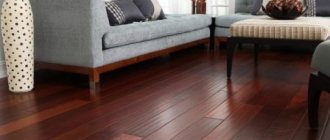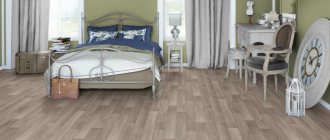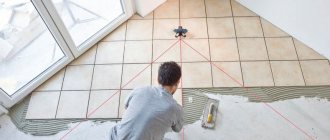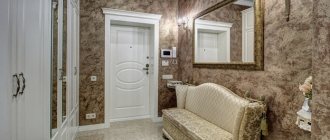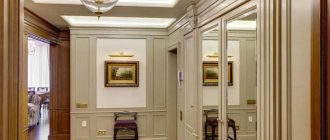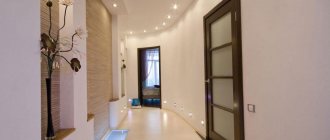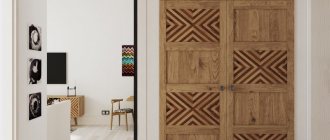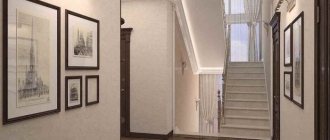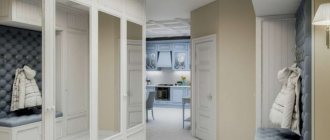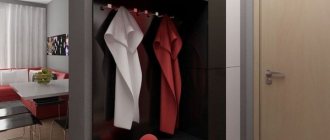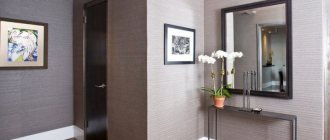The hallway is the first room in the apartment where a person enters. From it you can immediately determine the owner’s preferences, his habits, and the presence of design taste. Therefore, its design should be approached with special attention.
In order for the hallway to look like a single and complete project, the design of the flooring should not “argue” with the rest of the decoration: all materials should be combined with each other in color and texture.
The floor in the hallway is one of the most fragile, but important elements. It is affected daily by various unfavorable factors. Cold wind, draft, high humidity - this is a small list of possible problems. Therefore, you should carefully consider the design of the flooring so that it is as functional as possible and fits into the overall design style of the room.
To make it easy to keep the floor in the hallway clean, you need to choose the right materials for finishing it, taking into account the personal tastes of the owners and their lifestyle.
No. 1. Linoleum
Linoleum has been and remains the most popular material for finishing the floor in the hallway. This is explained by its low cost along with a lot of positive qualities: moisture resistance, durability, ease of care, a huge variety of colors .
Linoleum can be one of the following types:
- synthetic linoleum is familiar to each of us, and this is what is meant in 99% of cases when they talk about linoleum. The main advantage is the widest choice of design; the material can imitate wood, tile or the seabed, and quite accurately. It is inexpensive, but dents from heavy furniture will remain, as well as black marks from shoes. For a hallway with heavy loads, you can choose semi-commercial or commercial linoleum – such material will last longer than household material;
- natural linoleum, or marmoleum. This coating is more natural and environmentally friendly than synthetic linoleum, as it is made from wood chips, resin, chalk, and linseed oil. The material is durable, has antibacterial and fire-fighting properties, but is more expensive than its artificial counterpart, and its installation process is more labor-intensive;
- piece linoleum, also called vinyl tile. It has all the same properties as synthetic linoleum, but with the help of individual squares you can lay out interesting designs, create a mosaic, and if something happens, replacing one damaged element will not be difficult. So, if somewhere the covering is torn or pressed under the influence of a furniture leg or heel, then only one square will have to be replaced, and the hallway will again have a neat appearance.
No. 2. Ceramic tile
Ceramic tiles are another leader in the field of hallway floor finishing. The material has gained wide popularity due to a number of advantages that are invaluable in the hallway:
- high strength, wear resistance, moisture resistance, abrasion resistance;
- easy to maintain, resistant to various detergents;
- durability;
- environmental friendliness;
- a huge range of colors, patterns and sizes, so you can decorate the hallway in any style. In addition, tiles can imitate the surface of other materials.
Among the disadvantages of ceramic tiles, the only thing worth noting is that their surface is cold, but for a hallway this is not such a disadvantage. A more serious disadvantage is fragility. If a heavy object falls on the floor, there is a high probability that the tiles will be damaged.
It is worth noting that not just any tile is suitable for a hallway . So, you need to pay attention to strength, which is determined by classes from I to V. The most durable tiles of the V class are used in public spaces with a huge traffic of people, and for the hallway, material with strength III-IV is perfect. An important indicator will also be the resistance of the material to chemical influences: according to this indicator, tiles are divided into classes A, C and D. AA tiles are the most resistant to chemicals, but at the same time quite expensive, and AC class material is optimal for a hallway. And one more requirement for tiles in the hallway is the most non-slip surface, so it is better to pay attention to products with a matte or corrugated surface.
Which flooring to choose depending on the size and layout of the hallway?
Most often the corridors are small. In this case, you should focus on the visual expansion of the space. For this it is better to use light materials. A dark floor, on the contrary, visually makes the room smaller. This is appropriate in the Japanese style.
The Japanese-style floor looks very original and unusual.
Note! When decorating the interior of the hallway, adhere to unity. The most successful color options are gray or beige.
No. 3. Porcelain tiles
This material has become widespread relatively recently, and today, based on all its indicators, it is considered a unique method of finishing floors. In most properties, porcelain stoneware resembles ceramic tiles, but the peculiarities of manufacturing technology make it possible to obtain an even more durable material, which is superior in characteristics to tiles and even stone.
The main advantages of porcelain stoneware are:
- high strength;
- resistance to abrasion, moisture and fire;
- durability;
- safety;
- ease of care;
- sufficient assortment. Porcelain tiles can imitate any other material, have any color and pattern, and the surface can be embossed.
Among the disadvantages, it is worth noting the cold surface and high price. Porcelain tiles will serve you faithfully for many years, and any impact in the hallway, be it dog paws or dirty shoes after a walk in the rain, will not matter to such a coating. On the other hand, some experts express their doubts about the advisability of using such an expensive and so durable material in a residential area. The decision must be made in each specific situation, taking into account individual requirements and preferences.
The role of color and texture on the overall appearance of the interior
Tile is a material that is most often used for laying floors in the hallway, kitchen, bathroom and toilet. Tile manufacturers, trying their best, annually produce new shapes, textures, and combined options. The top layer of blocks can be embossed, smooth, or rough. All this makes it possible to create different design projects in apartments. Let's consider how tiles of different textures will look on the floor in the corridor.
Under the stone
Here you can use blocks of different shapes and textures. This is a good choice when decorating a room in a classic or country style. Stone-like tiles can convey different types of texture to the eye, having a characteristic pattern:
- basalt;
- slate;
- granite;
- quartzite.
And finishing the floor with marble will convey the brilliant, attractive texture of onyx, marble and agate.
You can use blocks of different shapes and textures
This material goes on sale in different shades, from monotonous to shades that include different inclusions. Some types of stone blocks are made of porcelain stoneware, which means they have a rough surface. For a floor in a corridor, this is a very good quality, as it will not be considered slippery.
It looks natural in the entrance area to the apartment. The remaining floor area can be designed as:
- sockets;
- whole ornaments;
- panel
Decorative borders with baseboards will also look good.
Wood effect
Wood in any design fills the house with naturalness, adds coziness and comfort. There are tiles on sale that imitate wood of different species:
- oak;
- pine;
- beech;
- wenge.
Each tree has its own unique pattern. You can add elitism to a room with just this tile by successfully choosing the texture and shades. The material is easy to care for and creates a seamless effect when laid.
Fills the house with nature
You can decorate the room with a decorative border, place the blocks in the form of a herringbone, wickerwork (like parquet) or in a spaced pattern. In a word, there are no restrictions in decorating the floor with wood-look tiles. Here the author himself has the right to choose the method of styling and decoration. As well as the type of pattern on the tile and color.
Mirror
Mirror reflection enlarges both space and objects. Using mirror tiles on the floor in the hallway, you can recreate a multifaceted effect. Sold with a matte edge reminiscent of precious metals or tinted. Lays in a square or diamond shape .
To create a decorative effect, craftsmen often decorate several areas with tiles speckled in a pattern. Not bad as a decoration; the built-in lighting will look great.
Beautiful hallway in light colors
Gray
Gray in floor design will give the room coldness, simplicity, and restraint.
Advice A plain gray floor is recommended for those who value laconicism and rigor in the interior. Often such a floor is diluted with some kind of ornament or pattern. Gray tiles on the floor of the corridors look natural.
A successful combination of gray with emerald, white, green, mirror inserts and wood textures. The gray scale has many shades, so tiles of this color can be used as a background . To create a classic style, gray should be combined with some dark color.
Gray – coldness, simplicity, restraint
Beige
Natural color is always relevant in creating design projects. The beige floor in the hallway is a practical option. Looks great in a duet with wooden furniture made in a classic design or with walls finished in wood, natural stone, simple or textured plaster.
The shape of the tiles in beige colors is made in the form of an elongated or equilateral rectangle. It can be plain, or it can imitate the structure of wood, so-called parquet boards. Using brown ones, you can create decorative borders and patterns in the corridor. Any installation methods can be used:
- in the form of squares;
- in a run;
- according to the type of parquet installation.
And also combine different shapes and sizes of tiles.
Natural color is always relevant
Brown
This color on the floor of the corridor will look neutral and expensive. In order to emphasize the nobility of the decoration on the walls or furniture made of natural wood, you can use brown floor tiles. Such an interior will look quite respectable. It is produced and sold in three versions: wood-look, stone-look or completely plain .
- It is more advisable to combine monochrome with decorative details - an accent insert, a pattern or a border.
- Brown wood-look will complement the interior with warmth, coziness and comfort.
- Stone will create a massive effect and add freshness to the room.
Looks neutral and expensive
No. 4. Laminate
Laminate is infrequently, but still used to decorate the hallway. This is a multi-layer coating that becomes a budget alternative to parquet, and at the same time can imitate not only any type of wood, but also tile or stone. Among other advantages of laminate it is worth highlighting:
- ease of installation and maintenance;
- strength;
- safety;
- good wear resistance;
- acceptable price.
Naturally, for the hallway it is better to choose a moisture-resistant laminate , as well as provide reliable waterproofing and treat the joints with moisture-resistant impregnation. Under such conditions, moisture will be practically harmless to the coating, but it is still better to wipe it off immediately if it gets on the floor. Laminate of classes 31 and 32 is perfect for the hallway, which will withstand the current loads. If the installation is done correctly, the laminate will turn into a durable coating. However, it is recommended to combine laminate with more durable coatings and... So, for example, the area near the threshold can be tiled, and laminate can be used in the rest of the hallway.
Trending flooring colors
Designers note that white shades are becoming increasingly popular in the latest season. Therefore, you should carefully select materials that are easy to clean. It is strictly not recommended to use black color - it shows up a lot of dirt.
With the help of floor design, you can visually change not only the size of the room, but also the character of the interior.
Now you know what floor to make in the hallway. The main thing is that the chosen solution is in perfect harmony with the overall interior and satisfies the aesthetic needs of the owners.
No. 5. Parquet board
If one person or a small family without animals or children lives in the apartment, then in the hallway you can use less durable materials, which include parquet boards . This material consists of three layers: the bottom two are inexpensive wood, and the top one is made of valuable species, which determines the appearance of the coating. It is the appearance that is the main advantage of a parquet board ; among its other advantages, it is worth noting its naturalness, environmental friendliness, and many installation options, thanks to which interesting solutions are achieved.
The three-layer structure of the material and the different directions of the fibers of the layers make it possible to increase resistance to humidity and temperature changes, and the protective coating and layer of varnish protect the parquet board from negative influences. On the other hand, parquet boards are not the cheapest materials; they will require careful care, which will not help if there are scratches from shoes, dirt and sand. You can sand the parquet board several times, after which the coating will not be repairable.
Block parquet has similar properties, but consists of solid wood. Hence the higher price, but also the opportunity to remove the top layer many times to renew the coating and give it a flawless look.
With frequent contact with dirt, both parquet floorings quickly lose their appearance, so they are rarely used in hallways. If the hallway is not the smallest, and you want to create a cozy classic interior using wooden floors, then it will be durable if you combine parquet with tiles near the threshold. Considering the variety of these types of coatings, as well as the ability to find tiles that imitate parquet, there should not be any difficulties.
Recommendations
The following designer tips will help you figure out what is best to choose from materials for the entrance group.
By color scheme
The choice of colors for the flooring in the hallway should be carried out simultaneously with the selection of material for the walls and taking into account the color scheme of future furniture.
It should be remembered that light colors will help visually expand the room, while dark colors, on the contrary, will reduce the volume. In addition, dust and stains from dirty shoes are very visible on a dark floor.
In small rooms, it is recommended to choose a floor covering that is a tone or semi-tone darker than the tone of the furniture.
For apartment
Unlike a country house, for a city apartment there are practically no restrictions on the use of flooring materials. In large rooms, it is recommended to lay tiles near the door, combining them with parquet boards in the hallway. In small hallways it is better to use only one finishing material.
For a country house
A modern country house is almost no different from urban housing in terms of comfort and amenities, but when decorating the entrance to a private cottage, additional restrictions must be taken into account. In a city dwelling, a person enters an apartment through the entrance, so some of the dirt and moisture remains on the staircase. In a country house, a person immediately enters the hallway, and therefore the requirements for coverage increase:
- it should not slide;
- it should not absorb or allow water to pass through.
Therefore, it is best to lay ceramic tiles or porcelain stoneware in the hallway of a private house.
No. 6. Carpet
Previously, carpets decorated many apartments, and their place was not only on the floor in the living room and bedroom, but also on the walls and even in the hallway. It is clear that a fleecy carpet and a room such as a hallway are incompatible things, but carpet is quite suitable. We are talking about artificial carpet , because natural carpet will absorb moisture too well and retain it, deteriorate and wrinkle.
Artificial carpet does not wrinkle, is easy to clean, and insects will not live in it. This coating makes the hallway cozy and soft. For these purposes, it is better to choose the most dense carpet, while the pile height should be minimal. The best option for a hallway is a carpet made of nylon , but analogues made of polyester, acrylic and polypropylene also perform well. There are several methods for making carpet, but woven carpet is better suited for a hallway - it is the most reliable, but there is not much of it on the market. Needle-stitched carpet is inferior in performance, but is also not afraid of dirt and water.
Parquet
Strong and durable oak parquet looks great, but it is expensive, and therefore can only be considered the best option when financial capabilities allow.
There is an alternative solution - to purchase a budget option; a beautiful floor covering is an imitation laminate.
No. 7. "Golden" tile
A material with a rather curious name appeared quite recently, and so far it is produced only in South Korea. The material is unique in all its properties, and all its characteristics are explained by a six-layer structure: the base is PVC, and on top of it are layers of crushed natural stone with resin, fiberglass, a wear layer, the top layer is a protective film.
Among the main advantages of this material it is worth noting:
- durability;
- wear resistance, which in the country of origin of this finishing material is determined by the number of steps. Thus, “golden” tiles will withstand 10 million steps, which means that the average family can walk on the material 24 hours a day for 10 years;
- resistance to moisture and fire, to household chemicals;
- comfortable to the touch and non-slippery surface;
- ease of care;
- the presence of a decent number of design solutions, up to the most accurate imitation of other finishing materials.
The price for such finishing material is average, and the only negative is that it is not so easy to find in stores.
No. 8. Self-leveling floor
Self-leveling flooring is an excellent option for any room, incl. and for the living room. The material can have any color and pattern: be either plain or with any pattern, imitate wood, the seabed, etc. In terms of its performance qualities, self-leveling flooring is a real godsend for a hallway . It is distinguished by such advantages as:
- wear resistance, resistance to moisture, mechanical influences, chemical agents;
- ease of care;
- solidity;
- durability.
In all respects, this is an excellent hallway covering, which, even despite many negative influences, will remain in its original form after many years. The cost of self-leveling floors is high; all work must be carried out by professionals, but such costs are offset by performance.
